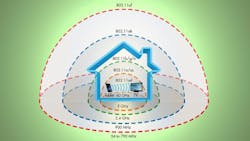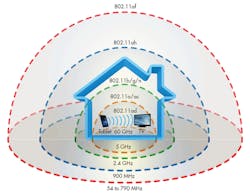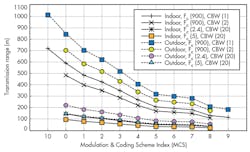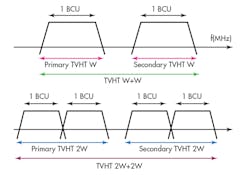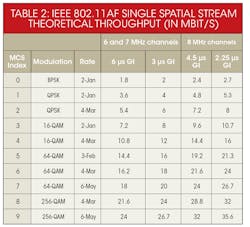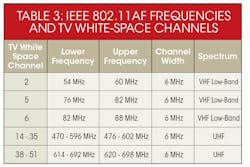What’s the Difference Between IEEE 802.11af and 802.11ah?
Download this article in .PDF format
The emerging Internet of Things (IoT) and machine-to-machine (M2M) communication markets demand wireless networking standards that operate in the sub-1-GHz spectrum, providing long-range and low-power operation. There also is a need to offload the data demands of smartphones and portable electronics from the cellular network.
The IEEE 802.11af and 802.11ah standards aim to solve these challenges by offering a Wi-Fi-like experience with reasonable data rates up to and beyond a kilometer. To do so, they occupy different parts of the 1-GHz spectrum and exhibit numerous other differences (Fig. 1 and Table 1).
Learn more about IEEE 802.11ah (Wi-Fi HaLow)
What is IEEE 802.11ah?
Making use of the 900-MHz licensed exempt bands could enable long-range and low-power wireless sensor networks (WSNs) and other massive, multiple-node wireless networks based on stations and relays. With IEEE 802.11ah, which is now widely known as Wi-Fi HaLow, the concept of a Wi-Fi-like wireless station can be realized. It promises range to 1 km at 1-, 2-, 4-, 8-, and 16-MHz channels with a minimum of 100-kbps throughput (Fig. 2). Maximum throughput for IEEE 802.11ah may reach as high as 40 Mbps.
This low-power and low-throughput mode enables short bursty data packets, which enable a very short on-time for remote or battery-powered sensors. The medium-access-control (MAC) protocols of the upcoming standard also enable smaller-frame formats, beaconless paging modes, and sensor traffic priority for lower-power applications.
It is likely that IEEE 802.11ah will use a downsampled version of the IEEE 802.11a/g specifications to service the 26 channels around 900 MHz (Fig. 3). Set to be finalized in early 2016, IEEE 802.11ah makes use of relay access points (RAPs) and network stations (STAs) in order to communicate frames from device to device. This relay function enables intelligent and low-power networking schemes that limit power use through an expansive network.
In addition, the modulation and coding scheme (MCS) level can be adjusted based on the quantity of data that needs to be transmitted. To limit energy consumption due to the overhead of relays and hopping, bi-directional hopping will be limited to two exchanges.
To increase energy efficiency and power savings, the target-wake-time (TWT) function in IEEE 802.11ah permits a routine and scheduled sleep time for each access point and station. The access points are grouped within a basic service set (BSS) along with restricted channel access to a designated group. The goal of this type of partitioning is to prevent multiple transmissions from networks that are unable to see each other. Sectorization can be implemented with electronically controlled antenna beams or a diversified set of antennas.
In the United States, up to 26 MHz of spectrum is available at 900 MHz, enabling up to 16 MHz of bandwidth for the standard. This increased bandwidth enables even higher-data-rate applications if necessary. Additionally, the MAC protocol is designed to account for a massive amount of nodes in an environment with the timing, paging, and sectorization protocols.
Given these factors, IEEE 802.11ah can provide an IP-based Wi-Fi-like system for M2M applications with much longer range and better material penetrating frequencies over earlier versions of Wi-Fi. IEEE 802.11ah is now included as part of an amendment to the 802.11REVmc standard with working group approval planned for January 2016.
What is 802.11af?
The IEEE 802.11 working group has already formed standards targeting the television white space (TVWS) in the very-high-frequency (VHF) band and lower end of the ultra-high-frequency (UHF) band from 54 to 790 MHz. In February 2014, the IEEE Std 802.11af -2013 amendment was approved, enabling wireless-local-area-network (WLAN) operation in TVWS (Fig. 4). As a product of the legacy analog TV, digital TV, and wireless microphone, this standard requires cognitive-radio functions that limit interference for these “primary” users.
In addition, IEEE 802.11af uses many of the recent operational enhancement techniques adopted by the most recent IEEE 802.11 standards, such as multiple-input multiple-output (MIMO), orthogonal frequency division multiplexing (OFDM), and channel bonding. Specifically, IEEE 802.11af offers the ability to bond up to four of the 6-to-8-MHz-wide channels (the channel bandwidth depends upon the regulatory domain), which can be blocked into either one or two contiguous blocks (Table 2). Up to four MIMO streams can be implemented in either multi-user (MU-MIMO) or space-time-block-code (STBC) operation.
In terms of data rates, the maximum available data rate per spatial stream for IEEE 802.11af is 35.6 Mbps at an 8-MHz channel bandwidth. The 6- and 7-MHz channel bandwidths are limited to 26.7 Mbps per spatial stream. Each additional spatial stream and bonded channel can theoretically compound-increase the data rate. The 6- and 7-MHz mode—operating with four channels and four MIMO streams—can potentially reach speeds of 426.7 Mbps. Under the same conditions, the 8-MHz mode reaches 568.9 Mbps.
Because IEEE 802.11af channels operate over a wide frequency range, propagation characteristics differ for the various channels. IEEE 802.11af may reach up to 1 km in range at maximum power with a single stream and channel and a lower data rate. This new VHF/UHF standard may be able to offer a reasonable Wi-Fi experience in ranges reaching several hundred meters.
IEEE 802.11af is being processed for an additional standard revision in the IEEE 802.11 working group letter ballots. This move is part of a revision to IEEE Std P802.11REVmc, which is predicted to gain approval in November 2015.
IEEE 802.11af vs. IEEE 802.1ah
When it comes to the MAC and physical layer (PHY) for IEEE 802.11af and 802.11ah, the most significant differences are derived from a divergence in functional intent and spectrum. IEEE 802.11ah occupies a contiguous block of spectrum in the 900-MHz licensed exempt band. In contrast, IEEE 802.11af occupies many various channels of TVWS in pre-licensed bands. Its operation is limited based on potential regional interference.
IEEE 802.11af is designed to operate more like a traditional Wi-Fi network. Using many of the latest developments, it is able to increase bandwidth over a long-range wireless local-area network (WLAN). In contrast, IEEE 802.11ah is better suited for M2M and IoT applications. It is designed for low-power communication between a wireless network’s APs and station nodes.
In terms of transmit power, the new standards will be limited according to the same regulation of 100 mW maximum.
Generally, however, IEEE 802.11af will have a longer operating range—especially when operating in the low VHF band. In most regions, IEEE 802.11ah should demonstrate considerably higher throughput in a single stream than IEEE 802.11af. Yet this will not hold true in the United States, where IEEE 802.11af bandwidths can reach 8 MHz. Although single-stream throughput should be higher for IEEE 802.11ah, MIMO and channel-bonding aspects of IEEE 802.11af could enable it to outperform IEEE 802.11ah when multiple antenna or channels are available.
With the different MAC and PHY designs, the IEEE 802.11ah hardware should operate with higher power efficiencies than IEEE 802.11af—even at higher frequencies. In terms of power efficiency, remote and battery-operated applications may benefit more from IEEE 802.11ah than IEEE 802.11af. After all, IEEE 802.11ah can operate in bursty packet nodes and within a field of wireless nodes. Here, data sent by a node will only have to travel to the nearest node, limiting power consumption per bit.
The IEEE 802.11ah standard also boasts sectorization, bi-directional transmit opportunity (TXOP), restricted access window, and target wake times, which will help to enable lower-power M2M and IoT WSN applications. Conversely, IEEE 802.11af is optimized to exchange data in a more Wi-Fi-like manner. Its access points send and receive data from remote portable devices, instead of taking IEEE 802.11ah’s approach and using other APs and nodes.
About the Author
Jean-Jacques DeLisle
Jean-Jacques graduated from the Rochester Institute of Technology, where he completed his Master of Science in Electrical Engineering. In his studies, Jean-Jacques focused on Control Systems Design, Mixed-Signal IC Design, and RF Design. His research focus was in smart-sensor platform design for RF connector applications for the telecommunications industry. During his research, Jean-Jacques developed a passion for the field of RF/microwaves and expanded his knowledge by doing R&D for the telecommunications industry.
